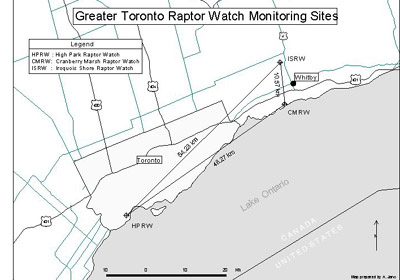Hawkwatch General Info
The Greater Toronto Raptor Watch (GTRW) was organised in 1993 through the efforts of John Barker who initiated the co–ordination of the Cranberry Marsh hawk watch in Whitby Ontario and the previously informal hawk watch in High Park in Toronto.
While raptor counting during fall migration had been conducted at both of these sites prior to 1995, there was an opportunity to standardise monitoring procedures and to benefit from exchanging and publishing annual data collected at each of these two sites.
In 1998 the GTRW was able to join the Toronto Ornithological Club as a special committee reporting to the records committee. This affiliation served to raise the awareness of the activities at each of the two sites while retaining the independence of each of the sites to take advantage of their geographic locations and staffing requirements. A third monitoring site has since been established at the Heber Down Conservation Area in North Whitby and is identified as the Iroquois Shoreline Raptor Watch.
Each of the three sites is staffed by experienced observers and each site has one designated counter each day who is responsible for the integrity of the observations, identifications and accuracy and clarity of field records.
The primary objective of the GTRW is to provide at all three locations a friendly and informative atmosphere where observers and visitors can experience the thrill of watching migrating hawks, falcons, eagles and vultures.
The second objective is to observe, identify and record the hourly species totals at a fixed location and in a time period running from late August to late November. There is no significant spring raptor migration at any of the three sites.
The third objective is to analyse the annual species totals between the three sites and compare current year to previous year totals, as well as comparisons with averages from previous years. In addition to totals, comparisons are also made on the standard measurement of birds per hour of observation. This analysis has been made available each year as an annual Greater Toronto Raptor Watch publication. From the 2000 season onwards, the report has been published via the internet.
The three sites are now recognised as major raptor monitoring locations because of their position near the north shore of Lake Ontario and particularly during periods of north–west winds associated with advancing cold fronts.
Visitors are most welcome at all three monitoring sites.
|
If you would like to particpate please to the organiser. |
